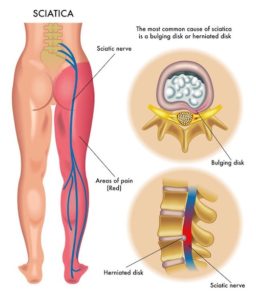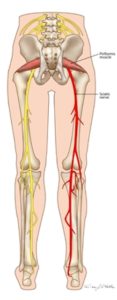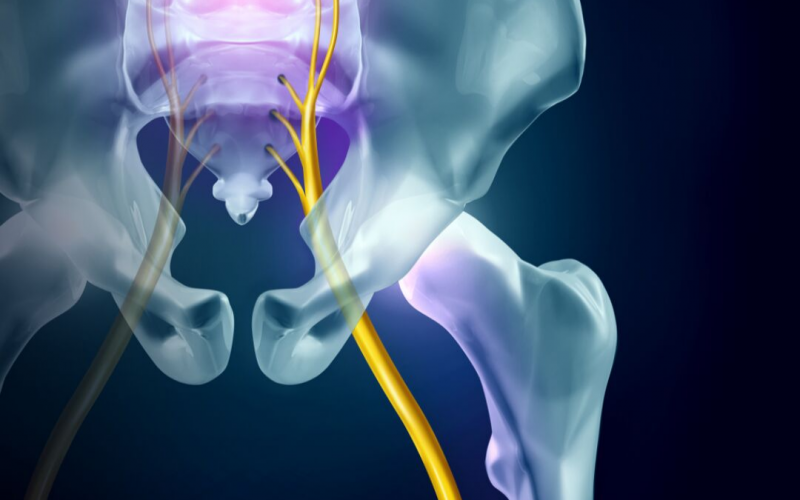Sciatica is a relatively common form pain affecting the leg; patients often misunderstand it. Medically sciatica is a set of symptoms rather than a diagnosis for what is causing the pain. Sciatica means that another spinal structure is compressing a person’s sciatic nerve.
Understanding Sciatica
The sciatic nerve is the largest single nerve in the human body; it runs from each side of the lower spine, buried deep in the buttock into the back of the thigh and all the way down the leg to the foot. It serves a vital role in connecting the spinal cord with the leg and foot muscles. Supplying information about movements of the leg and sends information about sensations back to the brain.
What is sciatica?
Sciatica is any pain and neurological symptoms along the route of the nerve, resulting in symptoms of pain, weakness, and numbness.
There are two types of sciatica:
- Acute sciatica, which lasts up to six weeks
- Chronic (persistent) sciatica, which lasts longer than six weeks
What happens to cause sciatica?
The most common cause of sciatica is a herniated spinal disc is the most common cause of sciatica. When this happens, the natural cushion between the vertebra of your spine is damaged or ruptures, causing the spinal disc to push out into areas usually occupied by nerves.
Note; other terms for a herniated disc include; a slipped, ruptured, bulging or, protruding disc.
Other conditions can also cause sciatica symptoms by irritating the nerve, these symptoms including; spinal stenosis, spondylolisthesis, or piriformis syndrome.
Additional risk factors
- Wearing high heels
- Being overweight
- Lack of regular exercise
The sciatic nerve can also be compressed or irritated by mechanical compression from a tight muscle, often in the buttock, or a protruding disc is pressing on it in the lower back, or by chemical irritation. The chemical ‘soup’ produced in the process of inflammation is irritating in itself, but the accumulation of liquid pressure in the limited space of the spinal joint can also compress the nerve.
What are the symptoms of sciatica?
Sciatica symptoms to vary from person to person, for some, the pain can be severe and debilitating, while for others, the pain sciatica might be infrequent and irritating. In either case, it has the potential to get worse. Sciatica usually affects one side of the lower body. Frequently, the pain extends from the lower back all the way to the back of the thigh and down through the leg. Depending on where the sciatic nerve is affected, the pain may also extend to the foot or toes.
Common symptoms of sciatica include:
- Constant pain in only one side of the buttock or leg (rarely in both legs)
- Pain in the buttock or leg that is worse when sitting
- Burning or tingling down the leg
- A cramping sensation of the thigh
- Tingling, or pins-and-needles sensations in the legs and thighs
- Weakness, numbness, or difficulty moving the leg or foot
- A constant pain on one side of the buttock
- A shooting pain that makes it difficult to stand up
How is it diagnosed
An osteopath will diagnose sciatica by taking a full medical history and by testing your back, hips, and legs for strength, flexibility, sensation, and reflexes. In some cases it may be necessary to request imaging to help clarify if there is a specific disc injury pressing on a nerve. X-Rays are not helpful in this situation/
Other tests may include:
- MRI scans
- CT scans
- Nerve conduction studies to determine the health or disease of a nerve
Will I get better from sciatica?
Sciatica is not a medical emergency. However, if you experience difficulty with bowel or bladder function, decreased sensation around the genitals, or progressive leg weakness, this may be the sign of cauda equina syndrome, a medical emergency. If you have these symptoms, contact your doctor or go to A&E immediately.
Please note: This is for guidance only, it should not be considered a substitute for medical advice, diagnosis or treatment given in person by an appropriately trained health professional.
In the next post; Sciatica: Treatment







